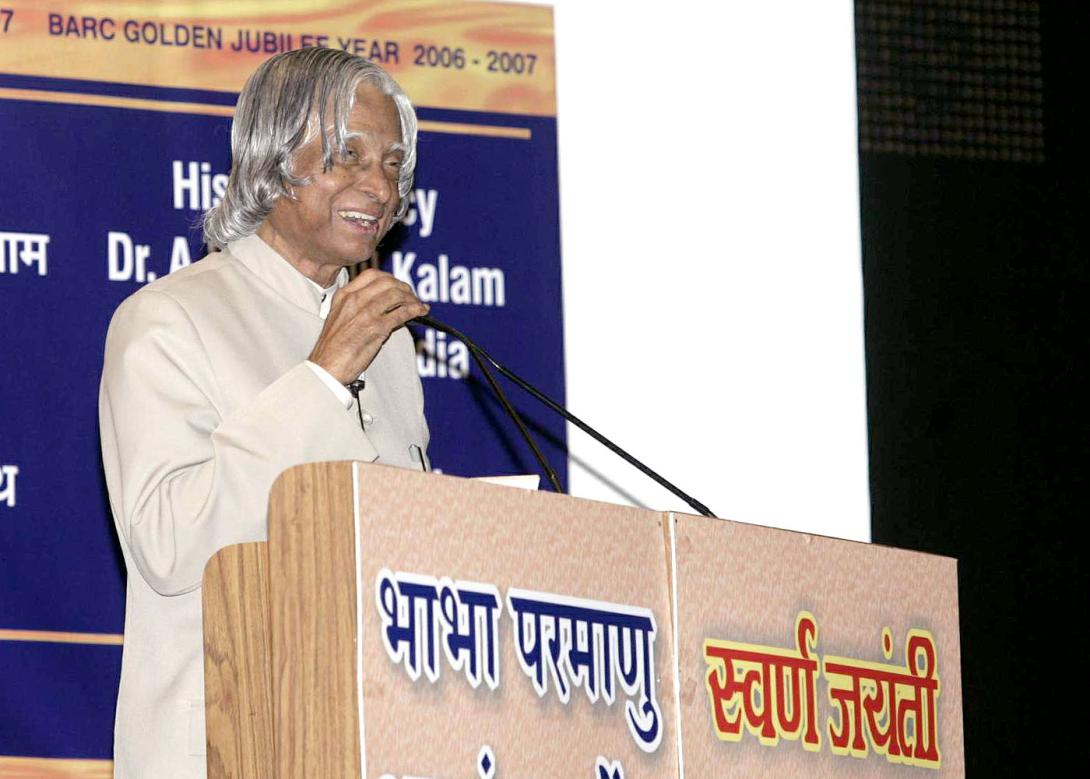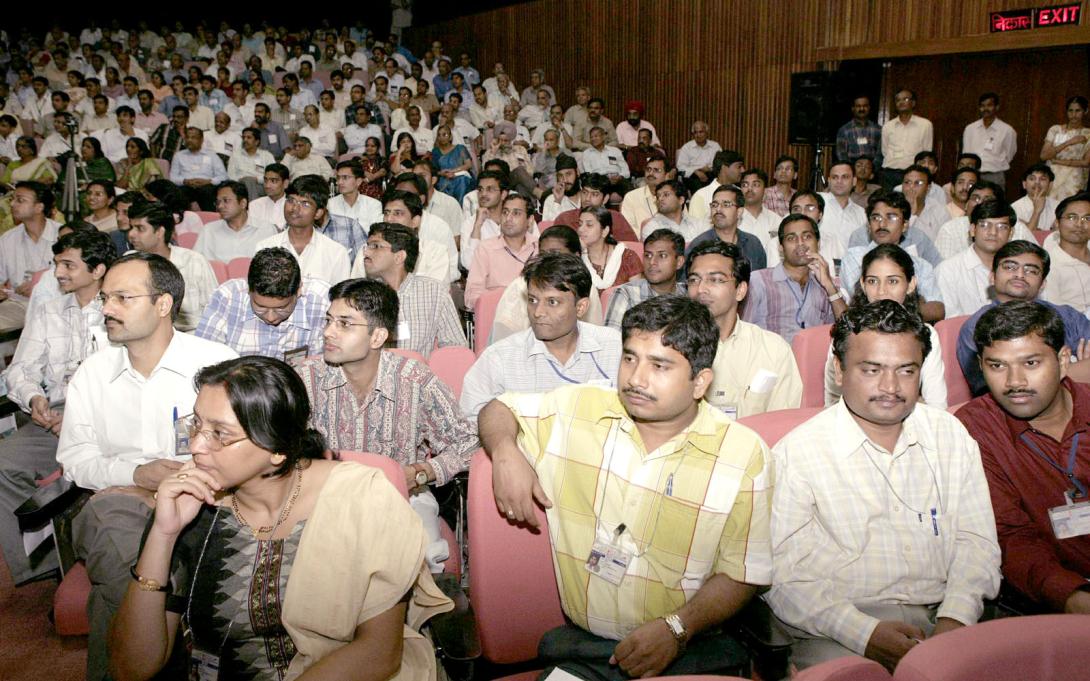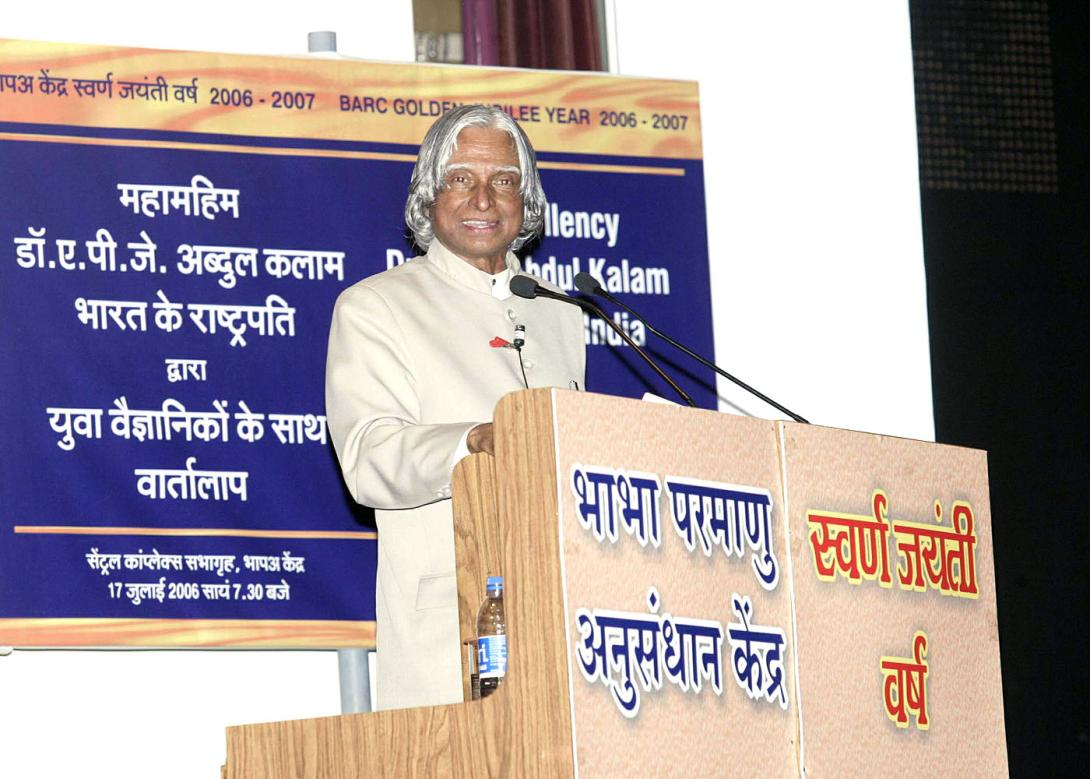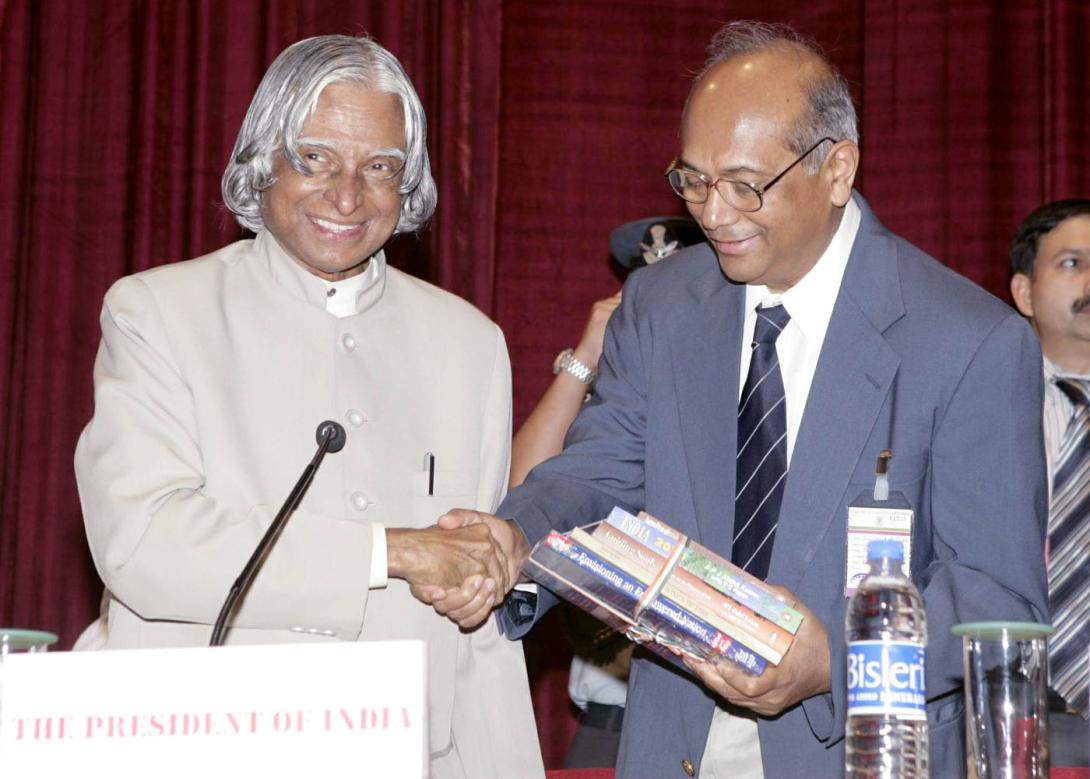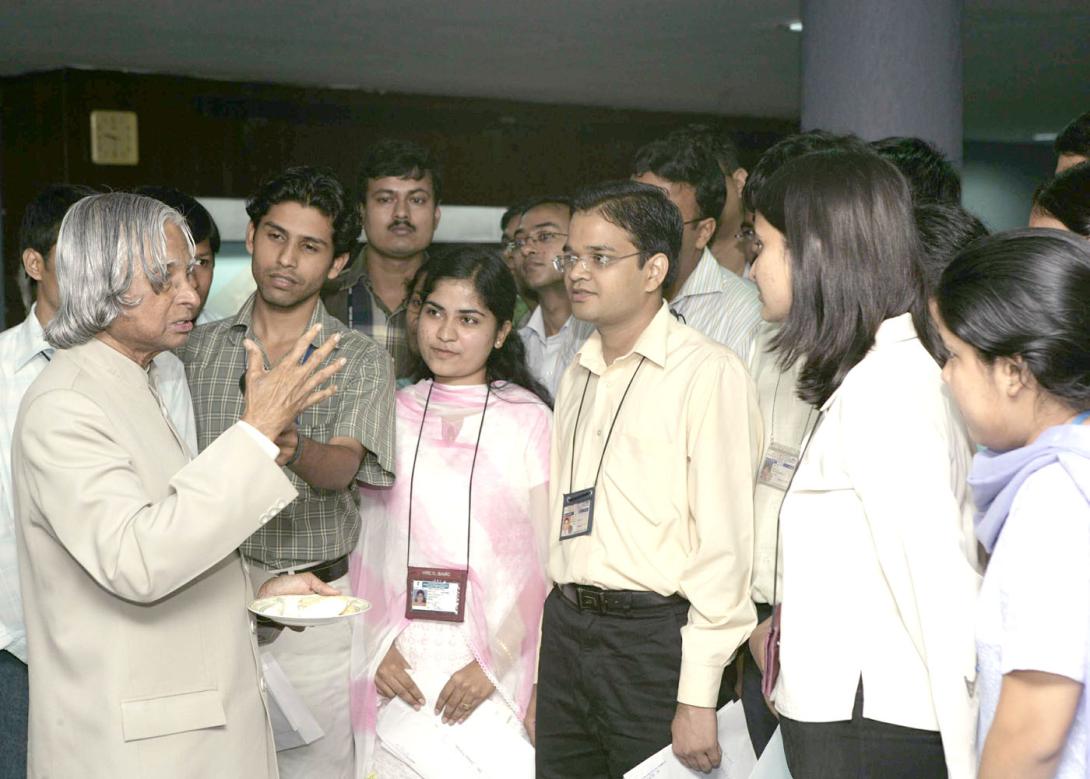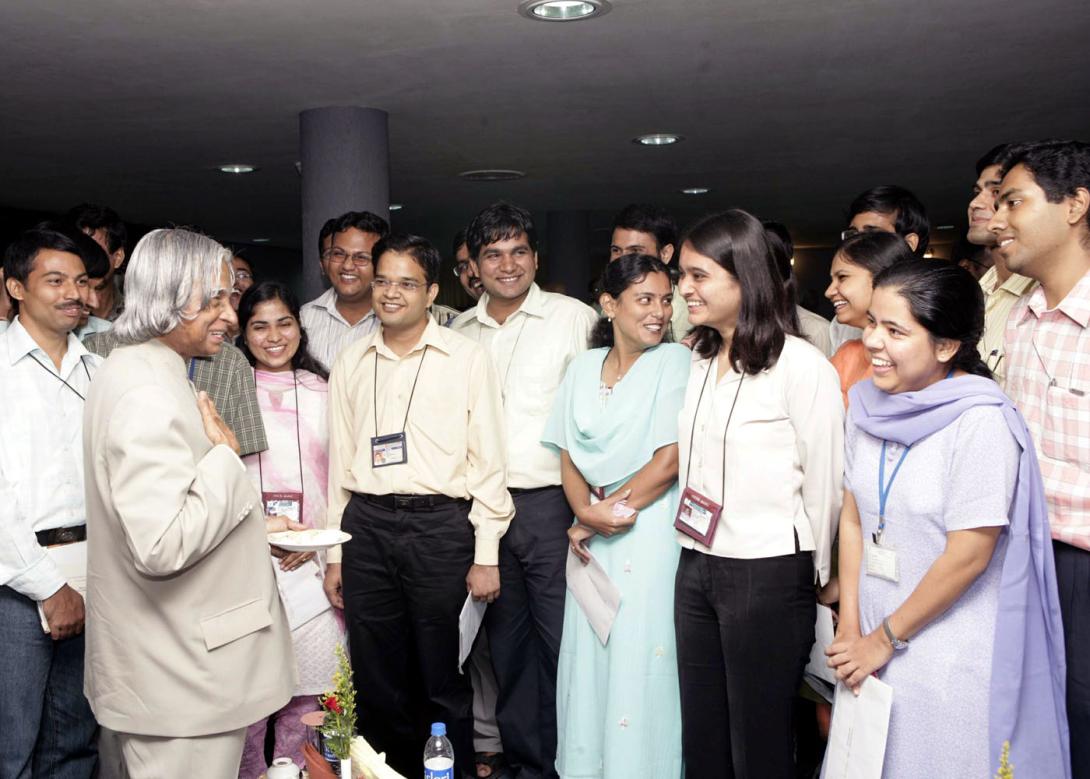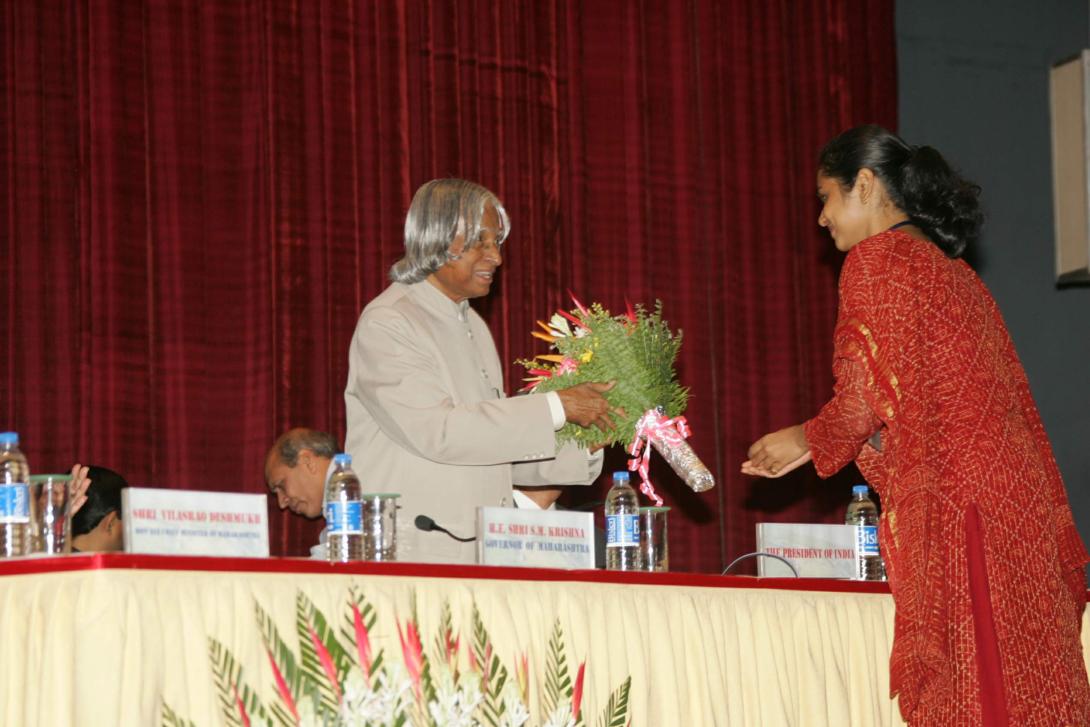Interaction With Scientists of Bhabha Atomic Research Centre Training School, Mumbai
Mumbai : 17-07-2006
Energy Independence
"Small aim is a crime"
I am indeed delighted to be in Bhabha Atomic Research Centre (BARC) Training School of the Department of Atomic Energy. BARC Training School has a mission of developing young human resource needed for all the atomic energy establishments. The training school has contributed significantly to the multiple missions of atomic energy and many other institutions in the country. Thus, BARC Training School has given many scientific and technological leaders such as Directors of Atomic Energy Establishments, Chairman, Atomic Energy Commission apart from many distinguished scientists. The institution also provided Scientific Advisors to the Minister of Defence. When I was working as a rocket engineer in Thumba Equatorial Rocket Launching Station (TERLS) in the year 1962, the first person who was received from the training school in my team was Dr. G. Madhavan Nair. We worked together for nearly 20 years. He worked with me during the development of India's first satellite launch vehicle (SLV-III). Later he was Programme Director for PSLV. You are all aware that Dr. G. Madhavan Nair is the Chairman of ISRO. Department of Atomic Energy has influenced Indian society in multiple fields. It has enabled the enhancement of agricultural production in certain areas through the use of irradiated seeds, radiation therapy for cancer treatment, and generation of electric power apart from contribution to national security.
I am happy to address and interact with the trainee scientists of the 49th batch and other young scientists. I would like to congratulate the BARC Training School on the occasion of the induction of the Golden Jubilee batch shortly. I was thinking what thoughts I can share with you today. Since you are in an organization which is responsible for development of energy, I have selected the topic of national importance which is "energy independence".
Energy Independence
In the field of energy, many innovations are taking shape. The world energy forum has predicted that fossil based oil, coal and gas reserves will last for less than ten decades. The energy is an important parameter for development. Continuously increasing cost of oil sourced from fossil material prompted many groups in the world to seriously consider the possible energy options. Based on our study, I have discussed about Energy Independence as part of my Independence Day Address to the nation, on 15 August 2005. There, I mentioned that Energy Independence has to be our nation?s highest priority. Our target is to achieve Energy Security by 2020 leading to Energy Independence by 2030 and beyond. Of course there were many discussions nationally as well as internationally on this subject. I would like to suggest certain actions to be taken on the energy missions for contributing towards energy independence in India.
Structure of Energy Sources
Based on the progress visualized for the nation during the next two decades, the power generating capacity has to increase to 400,000 MW by 2030 from the existing 130,000 MW. This has been arrived at taking into account the use of efficient transmission and distribution system and minimization of other losses. Energy independence has got to be achieved through three different sources namely hydel capacity, nuclear power and non-conventional energy sources primarily through solar energy, apart from thermal power. The hydel capacity generated through normal water sources and inter-linking of rivers is expected to contribute an additional 50,000 MW. Large scale solar energy farms of hundreds of megawatts capacity in certain number could contribute around 55,000 MW. The nuclear power plants should have a target of 50,000 MW of power. The balance 115,000 MW has to be generated through the conventional thermal plants through coal and gas and other renewable sources of energy such as Wind power, Biomass, Power through municipal waste and solar thermal power. The most significant aspect, however would be that the power generated through renewable energy technologies has to be increased to 25% against the present 5%. Let me discuss about the profile of renewable energy systems.
The energy mix for energy independence envisages use of four routes: (a) Hydel + Thermal till coal availability (b) Solar power using high efficiency CNT based SPV cells (c) Thorium based nuclear reactors (d) Bio-fuel for transportation sector.
Firstly I would like to talk to you on Solar Energy.
Solar Energy
Solar energy in particular has the potential for massive applications in the agricultural sector, where farmers need electricity exclusively in the daytime. This could be the primary demand driver for solar energy. Our farmers demand for electric power today is significantly high, which makes solar energy economical due to its large scale. Shortages of water, both for drinking and farming operations, can be met by large scale seawater desalination and pumping inland using solar energy, supplemented by bio-fuels wherever necessary.
We need to embark on a programme in solar energy systems and technologies, for both large, centralized applications as well as small, decentralized requirements concurrently, for applications in both rural and urban areas.
I would like to share about a decentralized rural power through solar energy in Sunderbans, West Bengal to promote the use of solar power. This pilot project has successfully created viable enterprises, targeting women entrepreneurs. These enterprises have been created not only to provide solar PV-based services in remote and interior villages, but also to provide repair and maintenance services to already existing products and systems. In view of Sunderbans remote location, difficult landscape and inadequate infrastructure, energy interventions based on alternate technologies such as solar power have become viable. About 20% of the area?s population, approximately 216,000 people are currently using solar PV electricity. I visited the solar villages in Sundarbans early this year.
Such experiences emphasize the need to create a "rural household solar mission" which will provide LED based nano crystal lighting system through small solar PV Power Plants to the 70 million households who are presently using kerosene oil for lighting. I am sure that this project will provide a very good business opportunity for energy industrialists.
Carbon Nano Tube (CNT) based solar cells for higher efficiency: The low efficiency of conventional Photo Voltaic (PV) cells has restricted the use of solar cells, for large power generation application. Research has shown that the Gallium Arsenide (GaAs) based PV cell with multi junction device could give maximum efficiency of less than 30%. Hence it is essential to launch a research mission on Carbon Nano Tube (CNT) based PV cell which has the potential for higher level of efficiency. Recent research has shown that the alignment of the CNT with the polymer composites substrate is the key issue and this aligned CNT based PV cells would give very high efficiency in photovoltaic conversion. In this process, the researchers could achieve the efficiency of about 50% at the laboratory scale. Our scientists have to take up this challenge and come up with the development of a CNT based PV cell with an efficiency of at least 50% within the next three years so that it can go into commercial production within five years. Solar power generation using high efficiency CNT based solar power photovoltaic cells will be highly competitive, compared to other forms of energy generation systems.
In addition, we should work on solar thermal power plants which use the thermal energy produced by the sun to generate electricity. They consist of three main components: mirrors, receivers and turbine technology. The power plants are highly efficient, producing a large quantity of green electricity with minimal environmental impact. A 64 MW solar power plant is being commissioned in Boulder City, Nevada, USA which is expected to provide power to the grid by 2007. Our entrepreneurs need to work on these technologies. There are lots of opportunities for research in fundamental science in this area and I would like to suggest the energy experts, environmentalists and entrepreneurs participating in this TERI function to work in a coherent, consorted way with a mission mode programme to achieve faster realization of commercial availability of CNT based PV cell with 50% efficiency and solar thermal power plants.
Let me now discuss with you on the power generation through nuclear energy.
Nuclear Energy
So far, the present nuclear power capacity which is around 3900 MW is expected to go to 7400 MW by 2010 with the completion of nine reactors which are now in progress. Eventually as per present plan of BARC and Nuclear Power Corporation the capacity by 2020 is expected to be increased to 24,000 MW. There is a need to plan right from now to increase this capacity to 50,000 MW by 2030.
Nuclear power generation has been given a thrust by the use of uranium based fuel. However to meet the increased needs of nuclear power generation, it is essential to pursue the development of nuclear power using Thorium, reserves of which are higher in the country. Technology development has to be accelerated for Thorium based reactors. Thorium is a non fissile material. For conversion of Thorium and maximizing its utilization development of Fast Breeder Reactor has been rightly taken up.
Two Experiences: I would like to recall two experiences. India?s nuclear programme has always been under technological denials for decades from many countries. Every one of the nuclear scientists and science leaders realized that the self-reliance is the most promising route. Nuclear scientists have always shown the country how nuclear technology can be used for increasing the agricultural produce, medical application and nuclear power generation.
Second Experience: Let me also share my second experience when I was the chief of Aeronautical Development Agency (ADA). It was 1998, India achieved a very important national milestone of becoming a nuclear weapon state. This accomplishment is yours. Many nations imposed technology denials and economic sanctions after the event. Particularly, the Light Combat Aircraft programme came to a halt because of collaborating countries breaking the agreements on the development contracts undertaken. I took an emergency meeting of the ADA Board and we formed a National Team for LCA control system with 20 members drawn from 7 organizations in the country with a two years project schedule. In 18 months, we realized a world class digital fly by wire control system for the LCA. Now, four LCA aircraft are flying and 5th one is getting ready for flight test. Cumulative flying hours logged by the 4 aircraft is over 500 hours. The batch production of LCA TEJAS is to commence. The message I would like to give to our nuclear scientists is:
"Nationally we have the best minds,
Enlist the national team,
The government and the people are with you,
Progress with your vast knowledge and experience, you will succeed."
As the transportation sector in India consumes about 90% of the total available oil, I would like to discuss the possible energy policy in this sector.
Energy in Transportation Sector
The Transportation sector in India is the fastest growing energy consumer. We import nearly $ 24 billion (Rs. 1,20,000 Cr.) of oil annually and are critically important for Indian economy and security. Our indigenous oil production meets only 25% of our total requirement. Hence, there is an urgent need to find alternative fuels and energy sources since the cost of crude oil has gone up to $ 78 per barrel. One of the promising areas for the country is production of bio-fuels. Simultaneously, we need to work on hydrogen based fuel and electric powered vehicles also. The report on National Hydrogen Energy Road Map, (Oct 2005) fixes a target of producing one million vehicles based on hydrogen energy and 1000 MW of power generating capacity based on hydrogen energy by 2020. Of course, it is a small component of total requirement.
Use of Biofuel: Recently, we had a Bio-diesel Conference towards Energy Independence in Rashtrapati Nilayam, Hyderabad on 9th and 10th June 2006, where all the stakeholders (farmers, entrepreneurs, marketing agencies, researchers, policy makers and NGOs) actively participated. The conference suggested the following mission mode actions.
(i) Realizing the production of 60 million tonnes of bio-diesel per annum by 2030 (this would be 20% of anticipated oil consumption in 2030).
(ii) As a first step towards reaching this target, a coordinated plan for achieving 6 million tonnes production by 2010 which would be 5% of the present import of oil.
(iii) To improve through research, the productivity of seed and extraction techniques and expand the area under bio-diesel crops towards achieving 30 million tonnes oil by 2020 and 60 million tonnes by 2030.
For realizing the above, the participants suggested the formation of Bio-fuel Corporation at the Center and Bio-fuel Boards in the States. Now, let me discuss power generation through municipal waste.
Power through Municipal Waste
In the power generation sector of the energy economy, we need to fully use the technologies now available for generating power from municipal waste. Presently, two plants are operational in India, each plant generating 6.5 MW of electric power one in Hyderabad and the other in Vijayawada. Studies indicate that as much as 6,000 MW of power can be generated by setting up 900 electric power plants spread over in different parts of the country which can be fueled by municipal waste. As it is known to you, municipal waste is generally considered to be a health liability. The electric power generation using municipal waste can help in the creation of clean environment and also add to the incremental power. I would recommend the scientific community to carry out further research and play a major role in establishing cost effective power plants using municipal waste in their area in collaboration with the local municipal authorities.
Conclusion
Since I am in the midst of young scientists of BARC, I would like to administer an oath on Courage, if you all agree.
COURAGE
Courage to think different,
Courage to invent,
Courage to discover the impossible,
Courage to combat the problems
And Succeed,
Are the unique qualities of the scientist.
As a scientist of Atomic Energy Establishment,
I will work and work with courage to achieve
Success in scientific discoveries and
Scientific achievements
My best wishes to all the scientists and technologists of Bhabha Atomic Research Centre for success in their mission of providing all the technological and scientific support for making India energy independent by 2030.
May God bless you.
Question and Answer Session
1. Nowadays talented people are not coming to do science. What you think can be done to improve this situation ?
- Shri Anil Jain, BARC Training School
Ans: Technologists should start demanding science. Science should become an assured career provider so that the parents can confidently send their children to science. Also, science curriculum must give interesting present day challenges to the students.
2. You have spent almost four decades as a scientist and science administrator. As youngsters, we would like to seek your advise in facing the challenges on the path of our scientific career.
- Adit Chakrabarty, Radiation Protection and Environmental Sience, BARC Training School
Ans: When you pursue a scientific career, you will always encounter problem. Problem should not become your master. You should defeat the problem and succeed. Work, work and work. Keep on acquiring new knowledge. This will equip you to face new challenges with confidence.
3. What are the main challenges before the country today?
- Roopashree Shrivastava, Radiation Protection and Environmental Sience, BARC Training School
Ans: Removing the poverty of 220 million people, increase literacy to 100%, employment generation for 40 million people all these will be accomplished through India vision 2020. We have to develop a spirit that "we can do it".
4. What was the most challenging difficulty you faced en route to your esteemed glory and how did you tackle/overcome it?
- Shri A.K. Tiwari, Chemical Engineering, BARC Training School
Ans: Failure management of SLV-3 first flight was definitely a challenging task for me and my team. That is the time I had the fortune of being with Prof Satish Dhawan who gave me practical experience of management which is not available in any text book of management.
5. Time has always been the winner in all the paths of the visions the country has had. Vision 2020 for India too has time as the challenging entity. What advise and words of experience would the Hon. President give us so that we accomplish our Milestone Vision 2020.
- Shri Vincent Shagaya Mageshkumar, Instrumentation Engineering, BARC Trainining School
Ans: We have to work collectively for realizing the vision of 2020. Scientists have to find "out-of-the-box" solution for all the problems facing the country irrespective of whether it falls in your domain of work or not. All of us must ask a question "what I can do for you". If this quality has been generated among our youth we will definitely make the impossible into possible.
6. How would you define a successful scientist and a failed scientist?
- Ms Revak Raj, Electronics Engineering, BARC Training School.
Ans: There is nothing like successful and failed scientists, it is a continuous process. For example, Newton's gravitational law led to Einstein's theory of relativity and now we are looking for Unified Field Theory. Continuous application of mind to solve problems is the task of a scientist.

